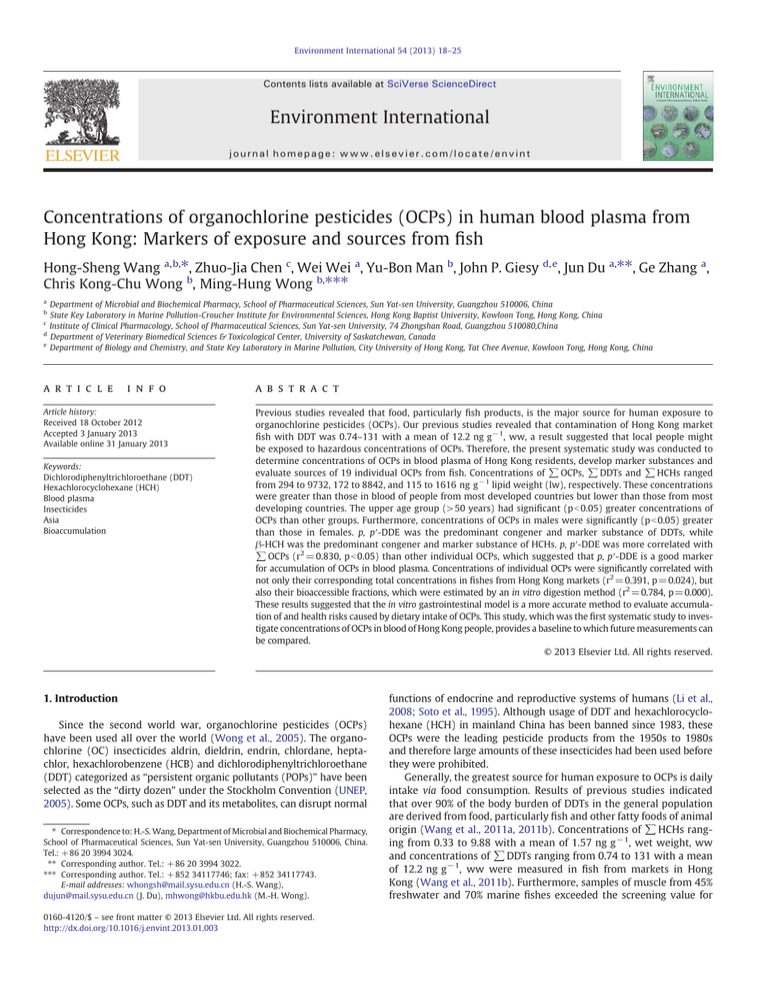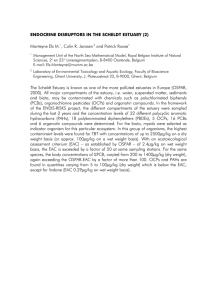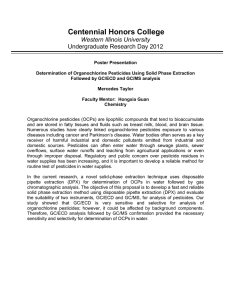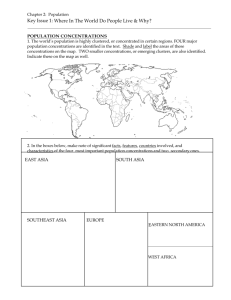Concentrations of organochlorine pesticides (OCPs) in human blood plasma from fish
advertisement

Environment International 54 (2013) 18–25 Contents lists available at SciVerse ScienceDirect Environment International journal homepage: www.elsevier.com/locate/envint Concentrations of organochlorine pesticides (OCPs) in human blood plasma from Hong Kong: Markers of exposure and sources from fish Hong-Sheng Wang a, b,⁎, Zhuo-Jia Chen c, Wei Wei a, Yu-Bon Man b, John P. Giesy d, e, Jun Du a,⁎⁎, Ge Zhang a, Chris Kong-Chu Wong b, Ming-Hung Wong b,⁎⁎⁎ a Department of Microbial and Biochemical Pharmacy, School of Pharmaceutical Sciences, Sun Yat-sen University, Guangzhou 510006, China State Key Laboratory in Marine Pollution-Croucher Institute for Environmental Sciences, Hong Kong Baptist University, Kowloon Tong, Hong Kong, China Institute of Clinical Pharmacology, School of Pharmaceutical Sciences, Sun Yat-sen University, 74 Zhongshan Road, Guangzhou 510080,China d Department of Veterinary Biomedical Sciences & Toxicological Center, University of Saskatchewan, Canada e Department of Biology and Chemistry, and State Key Laboratory in Marine Pollution, City University of Hong Kong, Tat Chee Avenue, Kowloon Tong, Hong Kong, China b c a r t i c l e i n f o Article history: Received 18 October 2012 Accepted 3 January 2013 Available online 31 January 2013 Keywords: Dichlorodiphenyltrichloroethane (DDT) Hexachlorocyclohexane (HCH) Blood plasma Insecticides Asia Bioaccumulation a b s t r a c t Previous studies revealed that food, particularly fish products, is the major source for human exposure to organochlorine pesticides (OCPs). Our previous studies revealed that contamination of Hong Kong market fish with DDT was 0.74–131 with a mean of 12.2 ng g−1, ww, a result suggested that local people might be exposed to hazardous concentrations of OCPs. Therefore, the present systematic study was conducted to determine concentrations of OCPs in blood plasma of Hong Kong residents, develop marker substances and evaluate sources of 19 individual OCPs from fish. Concentrations of ∑OCPs, ∑DDTs and ∑HCHs ranged from 294 to 9732, 172 to 8842, and 115 to 1616 ng g−1 lipid weight (lw), respectively. These concentrations were greater than those in blood of people from most developed countries but lower than those from most developing countries. The upper age group (>50 years) had significant (p b 0.05) greater concentrations of OCPs than other groups. Furthermore, concentrations of OCPs in males were significantly (p b 0.05) greater than those in females. p, p′-DDE was the predominant congener and marker substance of DDTs, while β-HCH was the predominant congener and marker substance of HCHs. p, p′-DDE was more correlated with ∑OCPs (r 2 = 0.830, p b 0.05) than other individual OCPs, which suggested that p, p′-DDE is a good marker for accumulation of OCPs in blood plasma. Concentrations of individual OCPs were significantly correlated with not only their corresponding total concentrations in fishes from Hong Kong markets (r2 =0.391, p=0.024), but also their bioaccessible fractions, which were estimated by an in vitro digestion method (r2 =0.784, p=0.000). These results suggested that the in vitro gastrointestinal model is a more accurate method to evaluate accumulation of and health risks caused by dietary intake of OCPs. This study, which was the first systematic study to investigate concentrations of OCPs in blood of Hong Kong people, provides a baseline to which future measurements can be compared. © 2013 Elsevier Ltd. All rights reserved. 1. Introduction Since the second world war, organochlorine pesticides (OCPs) have been used all over the world (Wong et al., 2005). The organochlorine (OC) insecticides aldrin, dieldrin, endrin, chlordane, heptachlor, hexachlorobenzene (HCB) and dichlorodiphenyltrichloroethane (DDT) categorized as “persistent organic pollutants (POPs)” have been selected as the “dirty dozen” under the Stockholm Convention (UNEP, 2005). Some OCPs, such as DDT and its metabolites, can disrupt normal ⁎ Correspondence to: H.-S. Wang, Department of Microbial and Biochemical Pharmacy, School of Pharmaceutical Sciences, Sun Yat-sen University, Guangzhou 510006, China. Tel.: +86 20 3994 3024. ⁎⁎ Corresponding author. Tel.: +86 20 3994 3022. ⁎⁎⁎ Corresponding author. Tel.: +852 34117746; fax: +852 34117743. E-mail addresses: whongsh@mail.sysu.edu.cn (H.-S. Wang), dujun@mail.sysu.edu.cn (J. Du), mhwong@hkbu.edu.hk (M.-H. Wong). 0160-4120/$ – see front matter © 2013 Elsevier Ltd. All rights reserved. http://dx.doi.org/10.1016/j.envint.2013.01.003 functions of endocrine and reproductive systems of humans (Li et al., 2008; Soto et al., 1995). Although usage of DDT and hexachlorocyclohexane (HCH) in mainland China has been banned since 1983, these OCPs were the leading pesticide products from the 1950s to 1980s and therefore large amounts of these insecticides had been used before they were prohibited. Generally, the greatest source for human exposure to OCPs is daily intake via food consumption. Results of previous studies indicated that over 90% of the body burden of DDTs in the general population are derived from food, particularly fish and other fatty foods of animal origin (Wang et al., 2011a, 2011b). Concentrations of ∑HCHs ranging from 0.33 to 9.88 with a mean of 1.57 ng g −1, wet weight, ww and concentrations of ∑DDTs ranging from 0.74 to 131 with a mean of 12.2 ng g−1, ww were measured in fish from markets in Hong Kong (Wang et al., 2011b). Furthermore, samples of muscle from 45% freshwater and 70% marine fishes exceeded the screening value for H.-S. Wang et al. / Environment International 54 (2013) 18–25 DDTs set by USEPA (Cheung et al., 2007). Considering that fish contributed the largest portion of the dietary intake of DDTs (57%) for local residents (Guo et al., 2010), attention should be paid to accumulation of OCPs and associated risks to the health of residents of Hong Kong. Blood, milk and adipose can be good biomarkers to assess human exposure to organic pollutants (Mueller et al., 2008; Wang et al., 2011c). Compared with milk which can only be obtained from the female population and only during lactation, blood is more easily collected. Furthermore, blood can cover a wide range of ages of both genders. Therefore, blood is considered to be a good matrix in which to assess concentrations of pollutants in the general population. The objectives of the present study were to:1) determine concentrations of OCPs in 117 blood plasma samples representative of the local Hong Kong population; 2) determine factors affecting accumulation of OCPs; 3) identify marker substances for DDTs, HCHs and OCPs in blood plasma; and 4) evaluate contribution of fish consumption for body OCP accumulation based on our published total and bioaccessible concentrations of OCP in Hong Kong market fish (Wang et al., 2011b). 2. Materials and methods 2.1. Sample collection and preparation The present study has been approved by the Human Investigation Ethics Committee of Department of Biology, Hong Kong Baptist University. Detailed information about blood donors and blood collection has been reported previously (Wang et al., 2012). Briefly, blood plasma from 54 females and 63 males was collected by the Hong Kong Red Cross from February to July 2011. All participants were Southern Han Chinese and determined to be eligible as blood donors based on the screening by nurses before recruitment. The age of blood donors ranged from 17 to 63 and therefore were classified into five age groups as ≤20 (n= 9), 21–30 (n= 36), 31–40 (n= 22), 41–50 (n= 28), and ≥51 (n= 22). Because blood plasma in the present study was from those persons that are eligible as blood donors, children and people older than 65 were excluded. Samples of blood were collected with heparinized tubes, maintained at 4 °C, and centrifuged at 1000×g for 15 min to separate the plasma and kept at −20 °C until extraction. Lipid content was determined gravimetrically and the content of each sample was used to express concentrations of OCP on a lipid-normalized basis (Sjodin et al., 2001). 2.2. Extraction and instrumental analysis Procedures for extraction and cleanup were based on those applied in previous studies (Qin et al., 2011; Tsang et al., 2011; Wang et al., 2011a) with slight modifications. Briefly, blood plasma was spiked with internal standards (PCB-60 and PCB-137, 10 ng for each sample) and allowed to equilibrate over-night. An accurate volume of serum (typically 2 ml) was mixed with 2 ml formic acid and 2 ml water and equilibrated by ultrasonic treatment for 20 min. Then, solid phase extraction (SPE) was performed by the use of 1 g/6 ml Extract-Clean, HighCapacity C18 end capped cartridges (AlltechAssociates Inc. Carnforth, UK). Cartridges were washed with dichloromethane (DCM) and activated by the use of methanol and Milli-Q water before extraction. Before the column became dry, plasma was added and dried for 15 min by aspiration of ambient air. The target compounds were then eluted by the use of 15 ml of n-hexane: DCM (1:1, v/v). The extract was concentrated to 1 ml before clean up and fractionation on a florisil column as described previously (Wang et al., 2011b). The extracts were concentrated and resolved in n-hexane. Deuterated recovery standard, 100 ng g−1 tetrachloro-m-xylene (TCmX), was added to all extracts prior to instrumental analyses. The final volume for instrumental analysis of all samples was 100 μl. OCPs were quantitatively analyzed by the use of a Hewlett-Packard (HP) 6890 N gas chromatograph (GC) coupled with a HP-5973 mass selective detector (MSD) and a 19 30 m × 0.25 mm × 0.25 μm DB-5 capillary column (J & W Scientific Co. Ltd., USA). The mass spectrometry mode is selected ion monitoring (SIM). Sample injection volume was 1.0 μl. The oven temperature was programmed to go from 100 °C (initial time, 2 min) to 175 °C at a rate of 15 °C min −1, then 3 °C min −1 to 250 °C and held for 9 min. The 20 targeted OCP compounds included DDT and transformation products (o,p′-DDD, p,p′-DDD, o,p′-DDE, p,p′-DDE, o,p′-DDT and p,p′-DDT), HCHs (α-HCH, β-HCH, γ-HCH, and δ-HCH), CHLs (heptachlor, transChlordane, cis-Chlordane, trans-Nonachlor, and cis-Nonachlor), DRINs (aldrin, dieldrin, and endrin), HCB (hexachlorobenzene) and mirex. The peaks of p,p′-DDD and o,p′-DDT were combined as one because they were extremely close and difficult to distinguish. Details of quantification parameters of target compounds are described in Table S1. 2.3. QA/QC At regular intervals solvent blanks (n-hexane) were subjected to the entire analytical procedure to determine background interference. The blank values were not subtracted from the sample measurements because they are equal to the solvent baseline in most cases. For each set of 15 samples, a procedural blank, a sample duplicate, solvent spiked with known amount of OCPs, and known amount OCP standard solution were processed. Several quality control criteria were used to ensure correct identification and quantization of the target compounds: first, retention times matched with those of the authentic reference compounds; second, the ratios of the two characteristic ions were within 15% of the theoretical values; and third, the signal-to-noise (S/N) ratio was greater than 3 for the selected ions. If any of these three criteria failed, the congener was excluded. The limit of detection (LOD), defined as concentrations of analytes that gave rise to a peak with a signal-to-noise ratio (S/N) of 3, was determined for each analyte by the use of a batch standard (Table S1). Internal standards (PCB-60 and PCB-137) were used to determine the recoveries, which ranged from 87.5 to 107%. Recoveries of the solvent spiked samples for OCPs ranged from 91.2 to 109% (Table 1). 2.4. Data analyses Concentrations of OCP were reported in units of ng g −1, lipid weight (lw). Since recoveries were consistent and sufficiently great, concentrations were not adjusted for recovery. Statistical analyses were performed by the use of SPSS 17.0 for Windows. If the concentration of a congener was lower than the LOD, a value equal to half the LOD of the analytical method was attributed for statistical analysis, while it was set to zero for sum, mean and median calculations. Normality was confirmed by the Kolmogorov–Smirnov test. Independent t-tests were performed to compare concentrations of OCP in blood plasma of males and females. One-way ANOVA tests followed by Duncan's multiple range tests were used to determine if there were any significant difference (pb 0.05) in concentrations of OCP among age groups. Pearson correlation coefficients were used to determine associations between concentrations of OCPs in blood plasma with the age and lipid contents. Linear regression analysis was used to test the correlations between marker substances and their corresponding groups. 3. Results and discussion 3.1. Concentrations of OCPs Concentrations of 19 insecticides were quantified in plasma samples of males and females from Hong Kong (Table 1). Mirex was lower than the limit of detection in all samples of blood. Therefore, concentrations were not reported. Concentrations of ∑ OCPs ranged from 294 to 9732 ng g −1 lw (mean 1894, median 1451 ng g −1 lw). Concentrations of ∑ DDTs ranged from 172 to 8842 ng g −1 lw 20 H.-S. Wang et al. / Environment International 54 (2013) 18–25 Table 1 Concentrations of OCPs in blood plasma of humans from Hong Kong (ng g−1 lw). RR (%) Lipid content (%) o,p′-DDE p,p′-DDE o,p′-DDD p,p′-DDD +o, p′-DDT p,p′-DDT ∑DDTs α-HCH β-HCH γ-HCH δ-HCH ∑HCHs Heptachlor trans-Chlordane cis-Chlordane trans-Nonachlor cis-Nonachlor ∑CHLs Aldrin Dieldrin Endrin ∑DRINs HCB ∑OCPs 104 96.2 93.1 103 97.0 / 92.0 98.0 91.2 107 / 94.7 104 96.3 91.7 108 / 91.8 96.9 109 / 93.2 / Female(n = 54) Male(n = 63) p value Mean ± SD Median Range (min to max) DR Mean ± SD Median Range (min to max) DR 9.5 ± 4.5 22.9 ± 20.2 446 ± 517 180 ± 240 65.9 ± 49.3 99.3 ± 77.0 813 ± 554 21.8 ± 13.9 243 ± 130 161 ± 78.1 48.7 ± 35.1 475 ± 242 7.41 ± 6.77 2.09 ± 4.05 1.51 ± 2.94 0.14 ± 0.75 2.87 ± 1.24 14.0 ± 11.7 3.66 ± 1.32 5.13 ± 15.83 4.76 ± 5.49 13.6 ± 16.8 1.87 ± 1.41 1317 ± 683 7.60 14.9 224 36.9 49.6 75.2 768 17.8 221 151 32.9 399 5.33 ND ND ND 2.58 8.89 3.53 ND 2.70 8.37 1.78 1248 4.5–22 ND–75.4 ND–2212 ND–885 15.3–193 ND–261 172–2456 ND–49.8 46.1–436 44.8–306 6.00–132 115–873 ND–25.6 ND–15.1 ND–8.70 ND–3.88 ND–5.46 2.82–38.3 ND–6.28 ND–69.7 ND–24.4 ND–74.6 ND–4.62 295–3180 / 96.3 96.3 88.9 100 96.3 / 96.3 100 100 100 / 81.5 25.9 25.9 3.70 70.4 / 88.9 14.8 55.6 8.1 ± 3.5 59.1 ± 63.1 1252 ± 1832 277 ± 381 77.5 ± 41.4 112 ± 70.9 1776 ± 1719 37.6 ± 33.2 360 ± 157 236 ± 110 62.3 ± 32.9 696 ± 293 12.2 ± 9.06 3.53 ± 5.61 2.36 ± 4.01 1.45 ± 3.47 3.67 ± 2.11 23.2 ± 13.7 5.93 ± 3.15 ND 5.71 ± 7.47 11.8 ± 7.82 2.98 ± 1.70 2511 ± 1806 6.80 50.2 412 24.9 60.3 89.3 1289 27.7 346 219 57.2 675 9.44 ND ND ND 3.47 22.50 4.95 ND 2.69 9.77 2.91 2111 4.0–18 5.60–319 ND–8632 ND–1412 16.6–165 10.5–289 274–8842 8.75–135 105–886 72.9–515 14.5–160 211–1616 ND–30.8 ND–17.8 ND–15.4 ND–13.9 ND–8.09 6.26–56.4 ND–11.73 ND ND–26.9 3.48–22.4 ND–7.75 825–9734 / 100 96.7 96.7 100 100 / 100 100 100 100 / 96.7 33.3 30.0 16.7 80.0 / 96.7 0 63.3 / 93.3 59.3 0.01 0.03 0.25 0.34 0.53 0.01 0.02 0.00 0.00 0.14 0.00 0.03 0.27 0.36 0.05 0.09 0.01 0.00 0.12 0.58 0.62 0.01 0.00 Value in bold and italic represents statistical significance (p b 0.05); RR, recovery rate; DR, detection rate. (mean 1290, median 901 ng g−1 lw) and were greater than concentrations of ∑HCHs (115 to 1616, mean 578, median 574 ng g−1 lw), ∑CHLs (2.82 to 56.4, mean 18.6, median 12.9 ng g−1 lw), ∑DRINs (ND to 74.6, mean 13.5, median 8.84 ng g−1 lw), and HCB (ND to 7.75, mean 2.42, median 2.08 ng g−1 lw) in the present study (Fig. 1). Concentrations of ∑DDTs in blood plasma of the present study were significantly greater than the mean concentrations in blood of people from Japan (Fukata et al., 2005), Sweden (Glynn et al., 2000), Germany (Wittsiepe et al., 2008) and United Kingdom (Thomas et al., 2006), comparable with that in blood of people from Portugal (Cruz et al., 2003), but lower than that in blood of people from India (Kumar et al., 2006), Spain (Porta et al., 2008), Romania (Dirtu et al., 2006), and Mexico (Waliszewski et al., 2012) (Table 2). Concentrations of ∑DDTs in blood plasma were lower than those in maternal blood collected from individuals from Hong Kong (1311 to 2928, mean 1934 ng g −1 lw) (Tsang et al., 2011) or Guangzhou, South China (329 to 6164, mean 2464, median 1676 ng g −1 lw) (Qu et al., 2010). Concentrations of ∑HCHs in blood plasma of people from Hong Kong were significantly greater than those (1.9 to 386.6, median 43.7 ng g −1 lw) in blood of mothers in Guangzhou, a nearby city in 99% 75% Mean Median Concentrations (ng g-1, lw) Concentrations (ng g-1, lw) Max 25% Min Fig. 1. Concentrations (ng g−1 lw) of individual OCPs in human blood plasma collected in Hong Kong. south China (Qu et al., 2010). Concentrations of ∑HCHs in the present study were greater than those in blood plasma of people from Japan (Fukata et al., 2005), Sweden(Glynn et al., 2000), Germany (Wittsiepe et al., 2008), the United Kingdom (Thomas et al., 2006), and Portugal (Cruz et al., 2003), but lower than those in India (Kumar et al., 2006), Spain (Porta et al., 2008), Romania (Dirtu et al., 2006), and Mexico (Waliszewski et al., 2012) (Table 2). Collectively, concentrations of OCPs in blood plasma of people in Hong Kong were greater than those in most developed countries such as the United Kingdom, Germany, and Japan, but lower than that of blood plasma of persons in most developing countries such as Mexico and Romania. 3.2. Factors affecting concentrations of OCPs Results of previous studies indicated that age, body fat content and gender can influence accumulation of persistent lipophilic compounds such as OCPs (Lee et al., 2007; Pulkrabova et al., 2009). Earlier studies had established a relationship between OCP concentrations with age (Mishra et al., 2011). To evaluate the effects of age, the population was stratified into five age classes: 0–20, 21–30, 31–40, 41–50, and > 50 years and compared by One-way ANOVA. Significantly (p b 0.05) greater mean concentrations of ∑DDTs (2416 ng g −1 lw), ∑CHLs (30.8 ng g −1 lw), and ∑OCPs (3094 ng g −1 lw) were observed for the oldest group (>50 years). Statistically significant (p b 0.05) differences in concentrations of individual OCPs among age groups were also observed for o,p′-DDE, p,p′-DDE, o,p′-DDD, heptachlor, aldrin, and endrin. Results were similar to those of previous studies which indicated that there were significant correlations between age and concentrations of OCP in blood of people from India (Mishra et al., 2011), Japan (Kanazawa et al., 2012) and China (Lee et al., 2007). Gender has been suggested to be another factor which can influence concentrations of OCPs. Mean concentrations of ∑DDTs, ∑HCHs, ∑CHLs, HCB and ∑OCPs in females (813, 475, 14.0, 1.87, 1317 ng g −1 lw, respectively) were lower than those in males (1776, 696, 23.2, 2.98, 2511 ng g −1 lw, respectively). Concentrations of individual OCPs, including o, p′-DDE, p, p′-DDE, ∑DDTs, α-HCH, β-HCH, γ-HCH, heptachlor, cis-Nonachlor, and aldrin in females were significantly (t-test, p b 0.05) lower than those in males. It might be H.-S. Wang et al. / Environment International 54 (2013) 18–25 21 Table 2 The concentrations of DDTs and HCHs in human blood in different countries or regions, ng g−1 lw (ng ml−1). Country, region Samples Hong Kong Plasma Hong Kong China, Guangzhou Japan India, Delhi Sweden Germany United Kingdom Portugal, Coimbra Spain Romania Mexico Maternal serum Maternal serum Serum Blood Serum Blood Serum Serum Serum Serum Serum DDTs, ng g−1lw (ng ml−1) HCHs, ng g−1lw (ng ml−1) Reference Range Mean Median Range Mean Median 172–8842 (11.2–411) 1311–2928 329–6164 / / / / 1.3–2600 (12.5–814.9) / 446–34,930 1400–155,200 1290 (97.1) 1934 2464 124.3 (950) 836.1 (0.814) / (93.5) 4896 / 18,200 901 (74.7) / 2115 184 115–1616 (21.1–103) / 5.7–159.2 13–55 / / / 8.9–120 (1.08–114.4) 132–9071 177–12,180 200–27,400 578 (43.3) / 80.1 27.4 (750) 51.6 (0.113) / (10) 1291 / 4900 574 (41.6) / 54.7 26.0 / / (0.069) 15 / 957 1114 3100 that lactation and menstruation can reduce concentrations of OCP in females (Harris et al., 2001). These results were consistent with those of previous studies conducted in Spain (Luzardo et al., 2006) and India (Mishra et al., 2011) and suggested that males might be at greater risk for accumulations of OCP. Results of previous studies revealed that lipophilicity can cause greater accumulation of OCPs in people with greater fat content (Lee et al., 2007). In the present study, lipid contents were significantly correlated with concentrations of ∑DDTs (r2 = 0.335, p b 0.05), ∑HCHs (r2 = 0.728, p b 0.05), ∑CHLs (r2 = 0.584, p b 0.05), ∑DRINs (r2 = 0.335, p b 0.05) and ∑OCPs (r2 =0.456, pb 0.05), which is consistent with other studies that greater fat contents would result in greater concentrations of OCPs (Qin et al., 2011). 3.3. Congener profiles and potential contribution of sources Concentrations of individual OCPs decreased according to the following trends: DDTs> HCHs> CHLs > DRINs > HCB (Fig. 1). DDTs (172 to 8842, median 901 ng g−1 lw) were the predominant OCPs in human plasma samples collected in Hong Kong, accounting for 21.4 to 90.8% (median 63.5%) of ∑OCPs. This observation is consistent with those of previous studies which revealed that DDT contributed to the highest proportion of OCPs in fluids of humans including milk (Wong et al., 2005) and serum (Zhao et al., 2007) collected from China. HCHs occurred at the second highest concentrations of individual OCPs (115 to 1616, median 574 ng g−1 lw), which accounted for 8.56 to 74.8% (median 35.1%) of the ∑OCPs. This was consistent with the results of previous studies that found that HCHs were the second most predominant OCPs in blood of people in India (Kaushik et al., 2012) and Spain (Jakszyn et al., 2009). Proportions of CHLs, DRINs, and HCB to ∑OCPs (median 0.87, 0.60, and 0.15%, respectively) were lower than those of DDTs and HCHs in blood plasma collected from people in Hong Kong during the present study, but different from those observed in people of Bolivia (Arrebola et al., 2012) in which HCB had concentrations comparable to those of DDTs, but similar to the results of studies conducted in Brazil (Rudge et al., 2011) and Shanghai, China (Cao et al., 2011) whereas these individual OCPs had lower concentrations than DDTs. In the present study, p,p′-DDE was the predominant congener and accounted for 50.4 ± 32.4% (range from ND to 97.6%) of ∑DDTs. Furthermore, there were significant correlations between concentrations of p,p′-DDE and ∑ DDTs (r 2 = 0.920, p b 0.01), p, p′-DDE and ∑OCPs (r 2 = 0.830, p b 0.01) in blood plasma collected from people in Hong Kong. These results suggested that p,p′-DDE can be used as a marker substance for ∑OCPs and ∑DDTs, which will be discussed below. The ratio of p,p′-DDE/p,p′-DDT has been suggested as an indicator of whether the DDT observed was recently released from technical material or had been weathered in the environment (Qin et al., 2011). A p, p′-DDE/p, p′-DDT ratio less than 1 suggests a less aged source of (0.558) 100 / 3166 2420 10,700 The present study (Tsang et al., 2011) (Qu et al., 2010) (Fukata et al., 2005) (Kumar et al., 2006) (Glynn et al., 2000) (Wittsiepe et al., 2008) (Thomas et al., 2006) (Cruz et al., 2003) (Porta et al., 2008) (Dirtu et al., 2006) (Waliszewski et al., 2012) DDT (McConnell et al., 1996). The ratio observed in the present study (mean 47.2) was greater than that observed in Bangladesh (mean 1.19) (Zamir et al., 2009), thereby indicating that the metabolites of DDTs came from historical use of DDTs and there are limited fresh intake of DDTs by people in Hong Kong. Profiles of relative concentrations of DDTs in blood plasma of Hong Kong people were similar to those of children blood from Zhejiang, China (Shen et al., 2010) and maternal blood from women in Guangzhou, China (Qu et al., 2010). Of the isomers of HCH, β-HCH was the predominant isomer in blood plasma collected from residents of Hong Kong, with a median value of 221 and 346 ng g −1 lw in females and males, respectively. β-HCH accounted for 33.4 to 61.8%, median 51.3%, of ∑HCHs in blood plasma in the present study, which was lower than that in maternal blood from Guangzhou, China (mean 79.0%) (Qu et al., 2010). The concentration order of isomers detected was β-HCH> γ-HCH> δ-HCH> α-HCH. It has been suggested that if α-HCH/γ-HCHb 1, the main source is lindane, while 3 b α-HCH/γ-HCHb 7 indicates industrial origin (Qiao et al., 2010; Willett et al., 1998). The mean/median ratios of α-HCH/γ-HCH were found to be 0.16/0.11 (0.04 to 1.11) in blood plasma of the present study, which suggested historical sources of lindane (Qiao et al., 2010). This result was confirmed by previous studies where β-HCH was the dominant compound of the four HCH isomers in most tissues of humans when no new exposure of people to the industrial HCHs occurred (Qu et al., 2010). Similar profiles of HCH isomers have been reported for tissues of humans collected from other parts of China such as Shanghai (Zhou et al., 2012) and Zhejiang, China (Shen et al., 2010). 3.4. Marker substances for OCPs in plasma Statistically significant (p b 0.05) correlations among individual OCPs are listed at Table 3. Coefficients of determination (r 2) range from 0.07 to 0.96. The greatest correlation coefficient for ∑DDTs, ∑HCHs, ∑CHLs and ∑DRINs was p, p′-DDE (r 2 = 0.92), β-HCH (r2 = 0.94), heptachlor (r2 = 0.74), and endrin (r2 = 0.24), respectively. Positive correlations indicated that there are individual substances that could be used as marker substances for groups of organochlorines or ∑OCPs (Glynn et al., 2000). Linear regression was performed in cases when the coefficients of determination (r 2) were greater than 0.60. The correlation analysis indicated that p,p′-DDE might be a good marker substance for concentrations of ∑OCPs (Fig. 2A) and ∑DDTs (Fig. 2B). The regression between p,p′-DDE and ∑ OCPs showed a greater r 2 (0.83) than other individual OCPs. Similarly, β-HCH and heptachlor were good markers for HCHs (Fig. 2C) and CHLs (Fig. 2D), respectively. Due to the small rates of detection for individual DRINs and the small regression coefficients, there were no good marker substances for DRINs. 22 Table 3 Correlations (r2) for the correlation between concentrations of OCPs in plasma.⁎ o,p ′-DDE o,p ′-DDE 1.00 −0.07 1.00 p,p′-DDD + o,p ′-DDT p,p ′-DDT α-HCH β-HCH γ-HCH δ-HCH HCB Heptach t-Chl c-Chl t-Non c-Non Aldrin Dieldrin Endrin ∑DDTs ∑HCHs ∑CHLs ∑DRINs ∑OCPs H.-S. Wang et al. / Environment International 54 (2013) 18–25 o,p′-DDE p,p′-DDE o, p′-DDE p,p′-DDD + o,p ′-DDT p,p′-DDT α-HCH β-HCH γ-HCH δ-HCH HCB Heptach t-Chl c-Chl t-Non c-Non Aldrin Dieldrin Endrin ∑DDTs ∑HCHs ∑CHLs ∑DRINs ∑OCPs p,p ′-DDE 1 0.10 0.16 0.28 0.31 0.20 0.23 0.16 0.31 0.18 0.07 0.16 0.12 0.23 1.00 0.19 0.10 0.14 0.07 0.08 0.14 0.30 0.13 0.10 0.29 0.25 0.40 0.40 0.25 0.14 1.00 0.28 0.22 0.14 0.25 0.18 0.08 1.00 0.28 0.26 0.13 0.31 0.08 1.00 0.72 0.58 0.74 0.34 0.12 1.00 0.42 0.71 0.34 0.07 0.10 1.00 0.44 0.35 0.20 0.16 1.00 0.35 0.09 0.08 1.00 0.10 0.13 1.00 0.18 1.00 1.00 0.18 0.18 0.16 0.10 0.15 0.25 0.14 0.25 0.42 0.40 0.29 0.31 0.24 0.26 .020 0.07 0.28 0.30 0.12 0.94 0.38 0.10 0.27 0.15 0.26 0.09 0.62 0.50 0.15 0.19 0.29 1.00 0.27 0.10 1.00 1.00 0.09 0.58 0.92 0.26 0.28 0.13 0.18 0.14 0.83 0.31 0.33 0.12 0.24 0.15 0.36 0.12 0.86 0.32 0.14 0.79 0.37 0.40 0.07 0.37 0.74 0.07 0.14 Abbreviations: Heptach, Heptachlor; t-Chl, trans-Chlordane; c-Chl, cis-Chlordane; t-Non, trans-Nonachlor; c-Non,cis-Nonachlor. ⁎ All results of correlations are statistical significance (p b 0.05, 2-tailed). Correlation coefficients ≥ 0.60 in bold. 1.00 0.18 0.13 0.46 0.22 0.20 0.36 0.36 0.28 0.23 0.41 0.17 0.32 0.26 0.25 0.24 1.00 0.10 0.14 0.96 1.00 0.42 0.08 0.23 1.00 0.07 0.23 1.00 1.00 H.-S. Wang et al. / Environment International 54 (2013) 18–25 r2=0.830, p<0.01 (B) ∑DDTs vs p, p’-DDE ∑DDTs (ng g-1, lw) ∑OCPs (ng g-1, lw) (A) ∑OCPs vs p, p’-DDE p, p’-DDE (ng g-1, lw) (D) ∑CHLs vs Heptachlor ∑CHLs(ng g-1, lw) ∑HCHs (ng g-1, lw) β-HCH (ng g-1, lw) r2=0.920, p<0.01 p, p’-DDE (ng g-1, lw) (C) ∑HCHs vs β -HCH r2=949, p<0.01 23 r2=0.733 , p<0.05 Heptachlor (ng g-1, lw) Fig. 2. Linear regressions for the relationships between concentrations of ∑OCPs, ∑DDTs, ∑HCHs, ∑CHLs and their corresponding marker substances. (A) ∑OCPs vs p,p′-DDE; (B) ∑DDTs vs p,p′-DDE; (C) ∑HCHs vs β-HCH; (D) ∑CHLs vs Heptachlor. Using the equation obtained in the regression analysis, concentrations of ∑ OCPs, ∑ DDTs, ∑ HCHs and ∑ CHLs were estimated from their corresponding marker substances. The difference between estimated and observed concentrations was then calculated by (estimated/measured—1.0)×100. The median/mean values of differences for ∑OCPs, ∑DDTs, ∑HCHs and ∑CHLs were 2.12 (20.0), 10.8 (23.1), 2.03 (1.69), 19.4 (21.5), respectively. Collectively, these results suggested that the marker substance for human body accumulation of ∑DDTs and ∑OCPs was p, p′-DDE, of ∑HCHs and ∑CHLs were β-HCH and heptachlor, respectively. 3.5. Accumulation of OCPs via fish consumption Results of previous studies indicated that the main pathway for human exposure to OCPs is consumption of contaminated seafood (Wang et al., 2011b). Approximately 75% of DDT intake by Chinese Fig. 3. Correlations between total (A) or bioaccessible (B) concentrations of OCP individuals in market fish and their corresponding concentrations in blood plasma of Hong Kong residents. 24 H.-S. Wang et al. / Environment International 54 (2013) 18–25 can be attributed to consumption of fish products (Nakata et al., 2002). Concentrations of DDTs and HCHs in human milk from women in Hong Kong were significantly correlated with frequencies of consumption of fish (Wong et al., 2005). Therefore, the correlations between body accumulation of OCPs and consumption of fish were investigated in the present study. Total concentrations of individual DDTs or HCHs and their corresponding bioaccessible concentrations in twenty fishes from markets in Hong Kong were obtained from a previous study (Wang et al., 2011b). Significant correlations were observed between concentrations of individual OCPs in human blood plasma and their corresponding total (r 2 = 0.391, p b 0.01) concentrations in fishes from Hong Kong markets (Fig. 3). These results confirmed that intake of OCPs from fish products is a major pathway for their accumulation by Hong Kong residents. Furthermore, the bioaccessible OCP concentrations in fish, which are the fraction of the OCPs mobilized from the fish muscle during gastrointestinal digestion and obtained by the use of an in vitro model in a previous study (Wang et al., 2011b), were analyzed with logistic regression to their corresponding concentrations in blood plasma. A better (r2 = 0.784, p b 0.01) correlation was observed between bioaccessible concentrations in fish and concentrations in blood plasma of Hong Kong residents. This result suggested that in vitro digestion model used in previous studies (Wang et al., 2010, 2011b) is a better method to evaluate the body accumulation and health risks for the dietary intake of organic pollutants. 4. Conclusions This was the first systematic study of concentrations of OCPs in blood plasma samples representative of the local Hong Kong population. Concentrations of ∑ OCPs ranged from 294 to 9732 ng g −1 lw, with a median value of 1451 ng g −1 lw. Although sample size was limited in this pilot stage of the investigation, the data in the present study provided enough evidences that body accumulation concentrations of OCPs, particularly DDTs and HCHs, were much greater than those in countries in Europe but lower than those in countries such as Romania and Mexico. Similar to the results of other studies, the age, body fat content and gender were found to significantly influence concentrations of OCPs in people from Hong Kong. DDTs contributed the greatest proportion of OCPs in blood plasma, followed by HCHs. p,p′-DDE and β-HCH were the predominant congeners of DDTs and HCHs, respectively. Bivariate correlations and linear regression analyses revealed that p,p′-DDE was a good marker for both ∑ OCPs and ∑DDTs, while β-HCH and heptachlor were good makers for ∑HCHs and ∑CHLs, respectively. Concentrations of individual OCPs in blood plasma were significantly correlated with their corresponding concentrations in fish muscle, particularly their digestible fraction evaluated by the use of an in vitro digestion model. It suggested that consumption of fish was the major source of OCPs in blood of people in Hong Kong. The in vitro digestion model is a better method than the total concentration to evaluate the body accumulation and health risks of dietary intakes of OCPs. Acknowledgments This research was supported by the China Postdoctoral Science Foundation (No. 2012M511868), the Seed Collaborative Research Fund from the State Key Laboratory in Marine Pollution (SCRF0003), the Fundamental Research Funds for the Central Universities (Sun Yat-sen University) (No. 12ykpy09), the National Natural Science Foundation of China (No. 31101071), the Science and Technology Planning Project of Guangdong Province, China (No. 2012B031500005), and the Research Grants Council of the University Grants Committee of Hong Kong (Collaborative Research Fund, HKBU1/CRF/08 and Special Equipment Grant, HKBU09). The research was supported, in part, by a Discovery Grant from the Natural Science and Engineering Research Council of Canada (Project # 326415-07). Prof. Giesy was supported by the program of 2012 “High Level Foreign Experts” (#GDW20123200120) funded by the State Administration of Foreign Experts Affairs, the P.R. China to Nanjing University and the Einstein Professor Program of the Chinese Academy of Sciences. He was also supported by the Canada Research Chair Program, an at large Chair Professorship at the Department of Biology and Chemistry and State Key Laboratory in Marine Pollution, City University of Hong Kong. Appendix A. Supplementary data Supplementary data to this article can be found online at http:// dx.doi.org/10.1016/j.envint.2013.01.003. References Arrebola JP, Cuellar M, Claure E, Quevedo M, Antelo SR, Mutch E, et al. Concentrations of organochlorine pesticides and polychlorinated biphenyls in human serum and adipose tissue from Bolivia. Environ Res 2012;112:40–7. Cao LL, Yan CH, Yu XD, Tian Y, Zhao L, Liu JX, et al. Relationship between serum concentrations of polychlorinated biphenyls and organochlorine pesticides and dietary habits of pregnant women in Shanghai. Sci Total Environ 2011;409:2997–3002. Cheung KC, Leung HM, Kong KY, Wong MH. Residual levels of DDTs and PAHs in freshwater and marine fish from Hong Kong markets and their health risk assessment. Chemosphere 2007;66:460–8. Cruz S, Lino C, Silveira MI. Evaluation of organochlorine pesticide residues in human serum from an urban and two rural populations in Portugal. Sci Total Environ 2003;317:23–35. Dirtu AC, Cernat R, Dragan D, Mocanu R, Van Grieken R, Neels H, et al. Organohalogenated pollutants in human serum from Iassy, Romania and their relation with age and gender. Environ Int 2006;32:797–803. Fukata H, Omori M, Osada H, Todaka E, Mori C. Necessity to measure PCBs and organochlorine pesticide concentrations in human umbilical cords for fetal exposure assessment. Environ Health Perspect 2005;113:297–303. Glynn AW, Wolk A, Aune M, Atuma S, Zettermark S, Maehle-Schmid M, et al. Serum concentrations of organochlorines in men: a search for markers of exposure. Sci Total Environ 2000;263:197–208. Guo J, Wu F, Shen R, Zeng EY. Dietary intake and potential health risk of DDTs and PBDEs via seafood consumption in South China. Ecotoxicol Environ Safe 2010;73: 1812–9. Harris CA, Woolridge MW, Hay AW. Factors affecting the transfer of organochlorine pesticide residues to breastmilk. Chemosphere 2001;43:243–56. Jakszyn P, Goni F, Etxeandia A, Vives A, Millan E, Lopez R, et al. Serum levels of organochlorine pesticides in healthy adults from five regions of Spain. Chemosphere 2009;76:1518–24. Kanazawa A, Miyasita C, Okada E, Kobayashi S, Washino N, Sasaki S, et al. Blood persistent organochlorine pesticides in pregnant women in relation to physical and environmental variables in The Hokkaido Study on Environment and Children's Health. Sci Total Environ 2012;426:73–82. Kaushik CP, Sharma N, Kumar S, Kaushik A. Organochlorine pesticide residues in human blood samples collected from haryana, India and the changing pattern. Bull Environ Contam Toxicol 2012;89:587–91. Kumar A, Baroth A, Soni I, Bhatnagar P, John PJ. Organochlorine pesticide residues in milk and blood of women from Anupgarh, Rajasthan, India. Environ Monit Assess 2006;116:1–7. Lee SA, Dai Q, Zheng W, Gao YT, Blair A, Tessari JD, et al. Association of serum concentration of organochlorine pesticides with dietary intake and other lifestyle factors among urban Chinese women. Environ Int 2007;33:157–63. Li J, Li N, Ma M, Giesy JP, Wang ZJ. In vitro profiling of the endocrine disrupting potency of organochlorine pesticides. Toxicol Lett 2008;183:65–71. Luzardo OP, Goethals M, Zumbado M, Alvarez-Leon EE, Cabrera F, Serra-Majem L, et al. Increasing serum levels of non-DDT-derivative organochlorine pesticides in the younger population of the Canary Islands (Spain). Sci Total Environ 2006;367:129–38. McConnell LL, Kucklick JR, Bidleman TF, Ivanov GP, Chernyak SM. Air–water gas exchange of organochlorine compounds in Lake Baikal, Russia. Environ Sci Technol 1996;30:2975–83. Mishra K, Sharma RC, Kumar S. Organochlorine pollutants in human blood and their relation with age, gender and habitat from North-east India. Chemosphere 2011;85: 454–64. Mueller JF, Harden F, Toms LM, Symons R, Furst P. Persistent organochlorine pesticides in human milk samples from Australia. Chemosphere 2008;70:712–20. Nakata H, Kawazoe M, Arizono K, Abe S, Kitano T, Shimada H, et al. Organochlorine pesticides and polychlorinated biphenyl residues in foodstuffs and human tissues from China: status of contamination, historical trend, and human dietary exposure. Arch Environ Contam Toxicol 2002;43:473–80. Porta M, de Basea MB, Benavides FG, Lopez T, Fernandez E, Marco E, et al. Differences in serum concentrations of organochlorine compounds by occupational social class in pancreatic cancer. Environ Res 2008;108:370–9. Pulkrabova J, Hradkova P, Hajslova J, Poustka J, Napravnikova M, Polacek V. Brominated flame retardants and other organochlorine pollutants in human adipose tissue samples from the Czech Republic. Environ Int 2009;35:63–8. H.-S. Wang et al. / Environment International 54 (2013) 18–25 Qiao M, An TC, Zeng XY, Zhang DL, Li GY, Sheng GY, et al. Safety assessment of the source water within the Pearl River Delta on the aspect of organochlorine pesticides contamination. J Environ Monit 2010;12:1666–77. Qin YY, Leung CK, Lin CK, Leung AO, Wang HS, Giesy JP, et al. Halogenated POPs and PAHs in blood plasma of Hong Kong residents. Environ Sci Technol 2011;45: 1630–7. Qu W, Suri RP, Bi X, Sheng G, Fu J. Exposure of young mothers and newborns to organochlorine pesticides (OCPs) in Guangzhou, China. Sci Total Environ 2010;408: 3133–8. Rudge CV, Sandanger T, Rollin HB, Calderon IM, Volpato G, Silva JL, et al. Levels of selected persistent organic pollutants in blood from delivering women in seven selected areas of Sao Paulo State, Brazil. Environ Int 2011;40:162–9. Shen H, Ding G, Han G, Wang X, Xu X, Han J, et al. Distribution of PCDD/Fs, PCBs, PBDEs and organochlorine residues in children's blood from Zhejiang, China. Chemosphere 2010;80:170–5. Sjodin A, Patterson DG, Bergman A. Brominated flame retardants in serum from US blood donors. Environ Sci Technol 2001;35:3830–3. Soto AM, Sonnenschein C, Chung KL, Fernandez MF, Olea N, Serrano FO. The E-screen assay as a tool to identify estrogens — an update on estrogenic environmentalpollutants. Environ Health Perspect 1995;103:113–22. Thomas GO, Wilkinson M, Hodson S, Jones KC. Organohalogen chemicals in human blood from the United Kingdom. Environ Pollut 2006;141:30–41. Tsang HL, Wu S, Leung CK, Tao S, Wong MH. Body burden of POPs of Hong Kong residents, based on human milk, maternal and cord serum. Environ Int 2011;37:142–51. UNEP. In: Found WW, editor. Stockholm Convention “New POPs”: screening additional POPs candidates; 2005. Waliszewski SM, Caba M, Herrero-Mercado M, Saldariaga-Norena H, Meza E, Zepeda R, et al. Organochlorine pesticide residue levels in blood serum of inhabitants from Veracruz, Mexico. Environ Monit Assess 2012;184:5613–21. Wang HS, Man YB, Wu FY, Zhao YG, Wong CKC, Wong MH. Oral bioaccessibility of polycyclic aromatic hydrocarbons (PAHs) through fish consumption, based on an in vitro digestion model. J Agric Food Chem 2010;58:11517–24. 25 Wang HS, Sthiannopkao S, Du J, Chen ZJ, Kim KW, Mohamed Yasin MS, et al. Daily intake and human risk assessment of organochlorine pesticides (OCPs) based on Cambodian market basket data. J Hazard Mater 2011a;192:1441–9. Wang HS, Zhao YG, Man YB, Wong CKC, Wong MH. Oral bioaccessibility and human risk assessment of organochlorine pesticides (OCPs) via fish consumption, using an in vitro gastrointestinal model. Food Chem 2011b;127:1673–9. Wang N, Shi LL, Kong DY, Cai DJ, Cao YZ, Liu YM, et al. Accumulation levels and characteristics of some pesticides in human adipose tissue samples from Southeast China. Chemosphere 2011c;84:964–71. Wang HS, Chen ZJ, Ho KL, Ge LC, Du J, Lam MH, et al. Hydroxylated and methoxylated polybrominated diphenyl ethers in blood plasma of humans in Hong Kong. Environ Int 2012;47C:66–72. Willett KL, Ulrich EM, Hites RA. Differential toxicity and environmental fates of hexachlorocyclohexane isomers. Environ Sci Technol 1998;32:2197–207. Wittsiepe J, Schrey P, Lemm F, Eberwein G, Wilhelm M. Polychlorinated dibenzop-dioxins/polychlorinated dibenzofurans (PCDD/Fs), polychlorinated biphenyls (PCBs), and organochlorine pesticides in human blood of pregnant women from Germany. J Toxicol Environ Health A 2008;71:703–9. Wong MH, Leung AO, Chan JK, Choi MP. A review on the usage of POP pesticides in China, with emphasis on DDT loadings in human milk. Chemosphere 2005;60: 740–52. Zamir R, Athanasiadou M, Nahar N, Mamun MI, Mosihuzzaman M, Bergman A. Persistent organohalogen contaminants in plasma from groups of humans with different occupations in Bangladesh. Chemosphere 2009;74:453–9. Zhao G, Xu Y, Li W, Han G, Ling B. Prenatal exposures to persistent organic pollutants as measured in cord blood and meconium from three localities of Zhejiang, China. Sci Total Environ 2007;377:179–91. Zhou J, Zeng X, Zheng K, Zhu X, Ma L, Xu Q, et al. Musks and organochlorine pesticides in breast milk from Shanghai, China: levels, temporal trends and exposure assessment. Ecotoxicol Environ Safe 2012;84:325–33.








